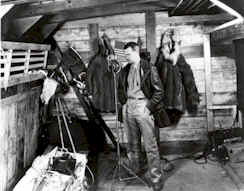Milestones:Long-Range Shortwave Voice Transmissions from Byrd's Antarctic Expedition, 1934: Difference between revisions
No edit summary |
No edit summary |
||
| (5 intermediate revisions by 3 users not shown) | |||
| Line 1: | Line 1: | ||
== Long-Range Shortwave Voice Transmissions from Byrd's Antartic Expedition, 1934 == | == Long-Range Shortwave Voice Transmissions from Byrd's Antartic Expedition, 1934 == | ||
Cedar Rapids, IA, 22 February 2001 - IEEE Cedar Rapids Section | [[Image:Byrd's Antartic expedition.jpg|thumb]] | ||
Cedar Rapids, IA, 22 February 2001 - [[IEEE Cedar Rapids Section History|IEEE Cedar Rapids Section]] | |||
''Beginning 3 February 1934, Vice Admiral Richard E. Byrd's Antarctic Expedition transmitted news releases to New York via short-wave radio voice equipment. From New York, the US nationwide CBS network broadcast the news releases to the public. Previous expeditions had been limited to dot-dash telegraphy, but innovative equipment from the newly formed Collins Radio Company made this long-range voice transmission feasible.'' | ''Beginning 3 February 1934, Vice Admiral Richard E. Byrd's Antarctic Expedition transmitted news releases to New York via short-wave radio voice equipment. From New York, the US nationwide CBS network broadcast the news releases to the public. Previous expeditions had been limited to dot-dash telegraphy, but innovative equipment from the newly formed Collins Radio Company made this long-range voice transmission feasible.'' | ||
'''The plaque can be viewed at the Linn County History Center, 615 First Ave. S. E., Cedar Rapids, Iowa, 52403.''' | |||
Just prior to Vice Admiral Byrd's Antarctica II Expedition, voice transmissions over shortwave had become a reality. Previous expeditions had used code to shortwave their messages. The change to voice was major and consequently, during 1933, quality was lacking. Mr. Collins careful attention to insulation, to reduction of high circulating currents and the reduction of stray RF fields helped to give the voice transmissions a thumbs up approval. "Clear as a Bell" was the response of many. | Just prior to Vice Admiral Byrd's Antarctica II Expedition, voice transmissions over shortwave had become a reality. Previous expeditions had used code to shortwave their messages. The change to voice was major and consequently, during 1933, quality was lacking. Mr. Collins careful attention to insulation, to reduction of high circulating currents and the reduction of stray RF fields helped to give the voice transmissions a thumbs up approval. "Clear as a Bell" was the response of many. | ||
Other new ideas which were later widely used in the radio field were multiple pre-tuned radio frequency bays which allowed frequency changes much more quickly, and unitized construction which gave the radio top-notch quality and reliability. A final important feature of the Type 20B Transmitter was called Class B modulation. Its application to low and medium powered transmitters was virtually pioneered by Collins Radio Company and was used to produce large audio power from relatively small tubes.< | Other new ideas which were later widely used in the radio field were multiple pre-tuned radio frequency bays which allowed frequency changes much more quickly, and unitized construction which gave the radio top-notch quality and reliability. A final important feature of the Type 20B Transmitter was called Class B modulation. Its application to low and medium powered transmitters was virtually pioneered by Collins Radio Company and was used to produce large audio power from relatively small tubes. | ||
<div class="header"><span class="head1">INNOVATION</span><span class="head2"> MAP</span></div> | |||
<!-- Byrd's Antarctic Expedition --> <googlemap | <!-- Byrd's Antarctic Expedition --> <googlemap controls="small" height="250" width="300" zoom="15" lon="-91.638685" lat="42.028337" version="0.9"> | ||
42.028337, -91.638685, | 42.028337, -91.638685, | ||
Long-Range Shortwave Voice Transmissions from Byrd's Antarctic Expedition, 1934 | Long-Range Shortwave Voice Transmissions from Byrd's Antarctic Expedition, 1934 | ||
Rockwell Collins, 400 Collins Rd, Cedar Rapids, Iowa, U.S.A. | Rockwell Collins, 400 Collins Rd, Cedar Rapids, Iowa, U.S.A. | ||
</googlemap> | </googlemap> | ||
[[Category: | [[Category:News|Shortwave]] [[Category:Radio communication|Shortwave]] [[Category:Radio broadcasting|Shortwave]] [[Category:Fields, waves & electromagnetics|Shortwave]] | ||
Revision as of 13:43, 5 April 2012
Long-Range Shortwave Voice Transmissions from Byrd's Antartic Expedition, 1934
Cedar Rapids, IA, 22 February 2001 - IEEE Cedar Rapids Section
Beginning 3 February 1934, Vice Admiral Richard E. Byrd's Antarctic Expedition transmitted news releases to New York via short-wave radio voice equipment. From New York, the US nationwide CBS network broadcast the news releases to the public. Previous expeditions had been limited to dot-dash telegraphy, but innovative equipment from the newly formed Collins Radio Company made this long-range voice transmission feasible.
The plaque can be viewed at the Linn County History Center, 615 First Ave. S. E., Cedar Rapids, Iowa, 52403.
Just prior to Vice Admiral Byrd's Antarctica II Expedition, voice transmissions over shortwave had become a reality. Previous expeditions had used code to shortwave their messages. The change to voice was major and consequently, during 1933, quality was lacking. Mr. Collins careful attention to insulation, to reduction of high circulating currents and the reduction of stray RF fields helped to give the voice transmissions a thumbs up approval. "Clear as a Bell" was the response of many.
Other new ideas which were later widely used in the radio field were multiple pre-tuned radio frequency bays which allowed frequency changes much more quickly, and unitized construction which gave the radio top-notch quality and reliability. A final important feature of the Type 20B Transmitter was called Class B modulation. Its application to low and medium powered transmitters was virtually pioneered by Collins Radio Company and was used to produce large audio power from relatively small tubes.
<googlemap controls="small" height="250" width="300" zoom="15" lon="-91.638685" lat="42.028337" version="0.9">
42.028337, -91.638685, Long-Range Shortwave Voice Transmissions from Byrd's Antarctic Expedition, 1934 Rockwell Collins, 400 Collins Rd, Cedar Rapids, Iowa, U.S.A. </googlemap>
